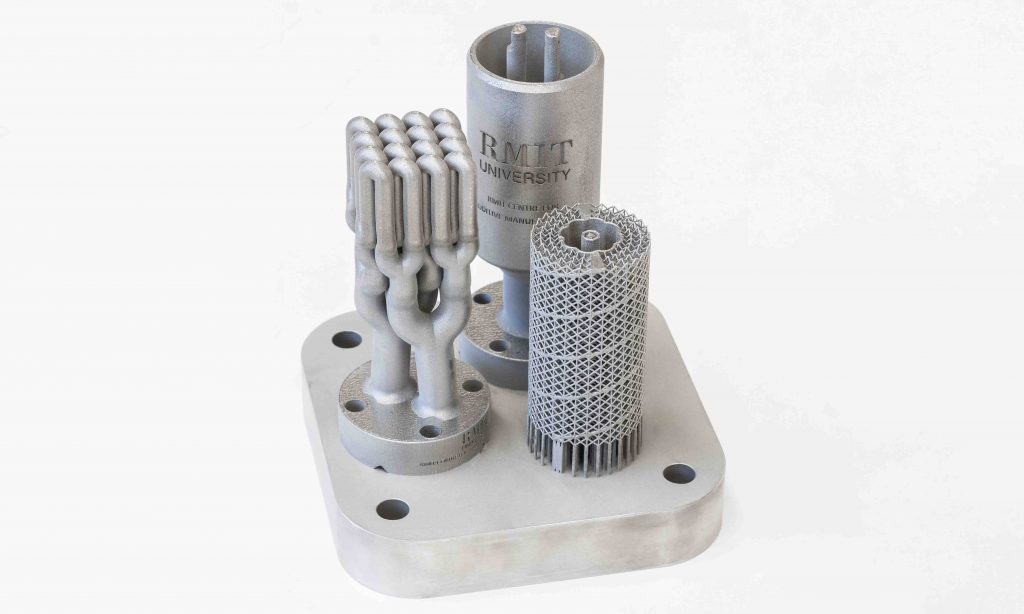Researchers at RMIT University, Australia, have developed a set of next-generation 3D printed cooling devices that could be the key to solving one of hypersonic flight’s biggest issues.
The 3D printed catalysts, as they’re called, are essentially metal heat exchangers coated in synthetic minerals known as zeolites. They’re cost-efficient to print and easy to scale, and use jet fuel as a coolant to control the temperature of their surroundings. The research team believes the advancement could potentially solve the problem of overheating in high-temperature applications such as hypersonic flight.
Dr Selvakannan Periasamy, the lead researcher of the study, said, “Our lab tests show the 3D printed catalysts we’ve developed have great promise for fuelling the future of hypersonic flight. Powerful and efficient, they offer an exciting potential solution for thermal management in aviation – and beyond. With further development, we hope this new generation of ultra-efficient 3D printed catalysts could be used to transform any industrial process where overheating is an ever-present challenge.”

The issue of temperature control
Hypersonic flight is defined as a speed of above Mach 5 (five times the speed of sound), or 6,500 km per hour. Running at maximum velocity, a hypersonic aircraft could theoretically travel from Europe to Australia in under three hours. Unfortunately, only a select number of experimental aircraft have ever reached Mach 5, as there are several engineering challenges that make it incredibly difficult. One of the biggest hurdles is in keeping the plane cool, as traveling at such speeds generates extreme heat.
According to co-author Roxanne Hubesch, repurposing fuel as a coolant is one of the most promising methods of treating the overheating issue.
She adds, “Fuels that can absorb heat while powering an aircraft are a key focus for scientists, but this idea relies on heat-consuming chemical reactions that need highly efficient catalysts.”
Due to the size and mass constraints of hypersonic aircraft components, the catalysts need to be as small as possible. As such, the team used SLM 3D printing to manufacture their heat exchangers and coated them with zeolites, turning them into the final usable catalysts.

A small-scale chemical reactor
So how do the catalysts actually work? When the 3D printed structures are exposed to heat, some of the base metal material moves into the zeolite coating. This is what enables the endothermic (heat-absorbing) reaction in the fuel flowing through the printed structure, cooling the surroundings in the process. When testing the functionality of their printed catalysts in a lab with simulated temperatures and pressures, the researchers found them to have ‘unprecedented efficiency’.
“Our 3D printed catalysts are like miniature chemical reactors and what makes them so incredibly effective is that mix of metal and synthetic minerals,” Hubesch explains. “It’s an exciting new direction for catalysis, but we need more research to fully understand this process and identify the best combination of metal alloys for the greatest impact.”
As far as future work goes, the RMIT team intends to optimize the 3D printed catalysts with the use of X-ray synchrotron techniques and other advanced analysis methods. The hopes are that the potential applications of the technology can be expanded to air pollution control for vehicles and air quality devices for indoor spaces.
Suresh Bhargava, Director of RMIT’s Centre for Advanced Materials and Industrial Chemistry, said, “This third generation of catalysis can be linked with 3D printing to create new complex designs that were previously not possible. Our new 3D printed catalysts represent a radical new approach that has real potential to revolutionise the future of catalysis around the world.”
Further details of the study can be found in the paper titled ‘Zeolites on 3D-printed open metal framework structure: metal migration into zeolite promoted catalytic cracking of endothermic fuels for flight vehicles’. It is co-authored by Suresh Bhargava, Roxanne Hubesch, Selvakannan Periasamy, et al.
Active cooling: a 3D printing application
One of the more niche applications of 3D printing technology is active cooling devices. Just last month, a team of U.S. researchers used 3D printing to create a novel, highly configurable metamaterial with modifiable thermal and electromagnetic properties. The reconfigurability of the metamaterial makes it multifunctional, with potential applications in active cooling for microprocessors, aircraft, and buildings.
Elsewhere, 3D printer manufacturer 3D Systems has previously partnered with the European Organization for Nuclear Research, CERN, to 3D print cooling components for the Large Hadron Collider (LHC). Specifically, the partners used the DMP Flex 350 PBF system to print a set of custom titanium cool-bars for use in particle detection experiments – components that would otherwise be impossible to manufacture.
Subscribe to the 3D Printing Industry newsletter for the latest news in additive manufacturing. You can also stay connected by following us on Twitter, liking us on Facebook, and tuning into the 3D Printing Industry YouTube Channel.
Looking for a career in additive manufacturing? Visit 3D Printing Jobs for a selection of roles in the industry.
Featured image shows a range of experimental designs for the 3D printed catalysts. Photo via RMIT University.


